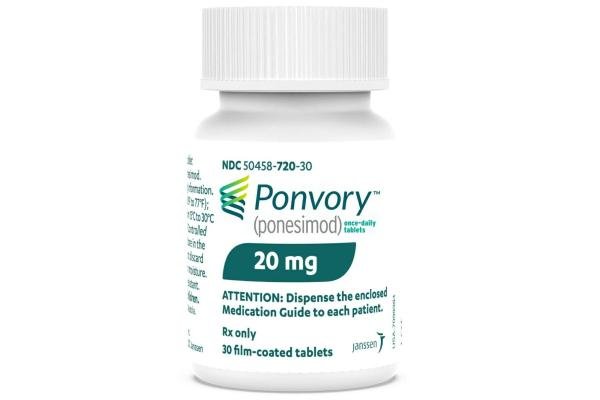Ponvory Dosage
Generic name: PONESIMOD 20mg
Dosage form: tablet, film coated
Drug class: Selective immunosuppressants
Medically reviewed by Drugs.com. Last updated on Apr 25, 2025.
Assessments Prior to First Dose of PONVORY
Before initiation of treatment with PONVORY, assess the following:
Complete Blood Count
Obtain a recent (i.e., within the last 6 months or after discontinuation of prior MS therapy) complete blood count (CBC), including lymphocyte count .
Cardiac Evaluation
Obtain an electrocardiogram (ECG) to determine whether preexisting conduction abnormalities are present. In patients with certain preexisting conditions, advice from a cardiologist should be sought and first-dose monitoring is recommended .
Determine whether patients are taking drugs that could slow heart rate or atrioventricular (AV) conduction .
Liver Function Tests
Obtain recent (i.e., within the last 6 months) transaminase and bilirubin levels .
Current or Prior Medications with Immune System Effects
If patients are taking anti-neoplastic, immunosuppressive, or immune-modulating therapies, or if there is a history of prior use of these drugs, consider possible unintended additive immunosuppressive effects before initiating treatment with PONVORY .
Vaccinations
Test patients for antibodies to varicella zoster virus (VZV) before initiating PONVORY; VZV vaccination of antibody-negative patients is recommended prior to commencing treatment with PONVORY . If live attenuatedvaccine immunizations are required, administer at least 1 month prior to initiation of PONVORY.
Recommended Dosage
Maintenance Dosage
After dose titration is complete (see Treatment Initiation) , the recommended maintenance dosage of PONVORY is 20 mg taken orally once daily starting on Day 15.
Administer PONVORY orally once daily. Swallow the tablet whole. PONVORY can be taken with or without food.
Treatment Initiation
A starter pack must be used for patients initiating treatment with PONVORY . Initiate PONVORY treatment with a 14-day titration; start with one 2 mg tablet orally once daily and progress with the titration schedule as shown in Table 1 .
| Titration Day | Daily Dose |
|---|---|
| Days 1 and 2 | 2 mg |
| Days 3 and 4 | 3 mg |
| Days 5 and 6 | 4 mg |
| Day 7 | 5 mg |
| Day 8 | 6 mg |
| Day 9 | 7 mg |
| Day 10 | 8 mg |
| Day 11 | 9 mg |
| Days 12, 13, and 14 | 10 mg |
| Maintenance | Daily Dose |
|---|---|
| Day 15 and thereafter | 20 mg |
If dose titration is interrupted, missed dose instructions must be followed .
First Dose Monitoring in Patients with Certain Preexisting Cardiac Conditions
Because initiation of PONVORY treatment results in a decrease in heart rate (HR), first-dose 4-hour monitoring is recommended for patients with sinus bradycardia [HR less than 55 beats per minute (bpm)], first- or second-degree [Mobitz type I] AV block, or a history of myocardial infarction or heart failure occurring more than 6 months prior to treatment initiation and in stable condition .
First Dose 4-Hour Monitoring
Administer the first dose of PONVORY in a setting where resources to appropriately manage symptomatic bradycardia are available. Monitor patients for 4 hours after the first dose for signs and symptoms of bradycardia with a minimum of hourly pulse and blood pressure measurements. Obtain an ECG in these patients prior to dosing and at the end of the 4-hour observation period.
Additional Monitoring After 4-Hour Monitoring
If any of the following abnormalities are present after 4 hours (even in the absence of symptoms), continue monitoring until the abnormality resolves:
- The heart rate 4 hours post-dose is less than 45 bpm
- The heart rate 4 hours post-dose is at the lowest value post-dose, suggesting that the maximum pharmacodynamic effect on the heart may not have occurred
- The ECG 4 hours post-dose shows new onset second-degree or higher AV block
If post-dose symptomatic bradycardia, bradyarrhythmia, or conduction related symptoms occur, or if ECG 4 hours post-dose shows new onset second degree or higher AV block or QTc greater than or equal to 500 msec, initiate appropriate management, begin continuous ECG monitoring, and continue monitoring until the symptoms have resolved if no pharmacological treatment is required. If pharmacological treatment is required, continue monitoring overnight and repeat 4-hour monitoring after the second dose.
Advice from a cardiologist should be sought to determine the most appropriate monitoring strategy (which may include overnight monitoring) during treatment initiation, if treatment with PONVORY is considered in patients:
- With some preexisting heart and cerebrovascular conditions
- With a prolonged QTc interval before dosing or during the 4-hour observation, or at additional risk for QT prolongation, or on concurrent therapy with QT prolonging drugs with a known risk of torsades de pointes
- Receiving concurrent therapy with drugs that slow heart rate or AV conduction
Reinitiation of PONVORY After Treatment Interruption
Interruption during treatment, especially during titration, is not recommended; however:
- If fewer than 4consecutive doses are missed:
- during titration: resume treatment with the first missed titration dose and resume the titration schedule at that dose and titration day.
- during maintenance: resume treatment with the maintenance dosage.
- If 4 or moreconsecutive doses are missed during titration or maintenance:
- treatment should be reinitiated with Day 1 of the titration regimen (new starter pack).
If treatment needs to be reinitiated with Day 1 of the titration regimen (new starter pack), complete first-dose monitoring in patients for whom it is recommended .
More about Ponvory (ponesimod)
- Check interactions
- Compare alternatives
- Pricing & coupons
- Drug images
- Side effects
- During pregnancy
- FDA approval history
- Drug class: selective immunosuppressants
- Breastfeeding
Patient resources
Professional resources
Related treatment guides
See also:
Further information
Always consult your healthcare provider to ensure the information displayed on this page applies to your personal circumstances.


